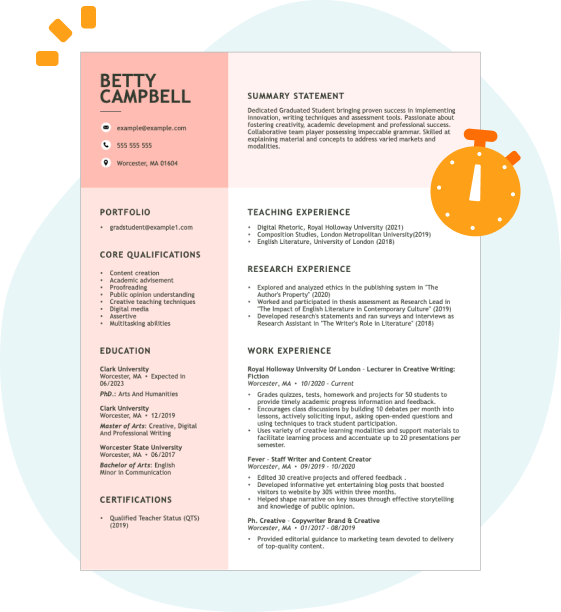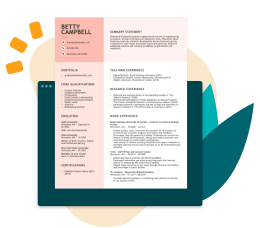Hard skills in film encompass technical abilities such as cinematography, editing, and sound design, which are essential for producing high-quality visual content.
Popular Film Resume Examples
Check out our top film resume examples that emphasize key skills like storytelling, cinematography, and editing expertise. These examples are designed to help you showcase your unique talents and experiences effectively.
If you're ready to build an impressive resume, the Resume Builder offers user-friendly templates specifically crafted for professionals in the film industry, ensuring your application stands out.
Film production specialist resume
The resume features a clean layout and resume fonts that improve readability, making it visually appealing. These design choices highlight the applicant's attention to detail and professionalism, helping their skills and experiences stand out effectively to potential employers.
Gaffer resume
This resume effectively integrates key skills such as professional lighting setup and energy-efficient lighting with extensive work experience. This combination allows employers to appreciate not only the job seeker's technical expertise but also their practical application in various film projects, showcasing their ability to contribute effectively on set.
Film director resume
This resume effectively organizes extensive film experience with clear headings and bullet points, making it easy to identify key roles and achievements at a glance. The use of concise language and strategic spacing highlights the applicant's impact in directing and producing, ensuring that hiring managers can quickly assess qualifications.
Resume Template—Easy to Copy & Paste
Yuki Nguyen
Minneapolis, MN 55412
(555)555-5555
Yuki.Nguyen@example.com
Skills
- Film Direction
- Video Production
- Creative Storytelling
- Project Management
- Team Leadership
- Budgeting and Cost Control
- Digital Editing
- Audience Engagement
Certifications
- Certified Film Director - American Institute of Filmmakers
- Advanced Video Production - Film Academy Online
Languages
- Spanish - Beginner (A1)
- French - Intermediate (B1)
- Italian - Beginner (A1)
Professional Summary
Accomplished Film Director skilled in creative storytelling and production management, with proven ability to increase audience engagement and maximize revenue through strategic direction and innovative content creation.
Work History
Film Director
Silver Screen Productions - Minneapolis, MN
February 2023 - October 2025
- Directed a film generating 2M revenue.
- Led a team of 50 for a cross-country production.
- Reduced costs by 15% through innovative strategies.
Video Producer
Visionary Media - Cedar Valley, MN
February 2020 - January 2023
- Produced ads increasing sales by 20%.
- Implemented digital workflows saving 10K.
- Enhanced visual quality resulting in 30% more viewers.
Creative Director
Innovative Film Studios - Cedar Valley, MN
January 2018 - January 2020
- Boosted audience engagement by 25%.
- Pioneered campaigns increasing brand value.
- Managed budgets up to 0K efficiently.
Education
Master's Film Production
University of Southern California Los Angeles, California
May 2017
Bachelor's Digital Media
New York University New York, New York
May 2015
How to Write a Film Resume Summary
Your resume summary is the first thing employers will notice, so it's important to make a strong impression that highlights your qualifications for the film industry. As a filmmaker, you should emphasize your unique storytelling abilities, technical skills, and collaborative spirit in this section. To help clarify what makes an effective summary, we’ll look at some examples that illustrate successful approaches and common pitfalls:
Weak resume summary
I am a passionate filmmaker with years of experience and a strong desire to create compelling stories. I seek opportunities where I can use my creativity and collaborate with talented teams. A job that offers growth and room for innovation is what I’m looking for, as I believe this will allow me to showcase my abilities.
- Lacks specific details about the filmmaker’s skills, such as types of films made or technical expertise
- Focuses on personal desires rather than what unique contributions the job seeker brings to potential employers
- Uses vague language like "passionate" and "strong desire," which does not provide concrete evidence of capability
Strong resume summary
Creative film director with over 8 years of experience in feature films and documentaries, known for compelling storytelling and innovative visual techniques. Increased audience engagement by 30% through the implementation of interactive marketing strategies for recent projects. Proficient in film editing software, scriptwriting, and collaborating with diverse production teams to deliver compelling cinematic experiences.
- Begins with clear indication of experience level and specific industry focus
- Highlights a quantifiable achievement that showcases success in audience engagement
- Demonstrates relevant technical skills that are essential for a film director role
PRO TIP
Showcasing Your Work Experience
The work experience section is the cornerstone of your resume in the film industry. This part contains the bulk of your content, and resume templates always emphasize this important section.
Structure it in reverse-chronological order, listing previous roles in film production or related fields. Use bullet points to succinctly highlight key achievements and contributions in each position.
To further clarify what creates an effective work history section, we’ve provided a couple of examples that illustrate best practices and common pitfalls:
Film Assistant
Creative Studios – Los Angeles, CA
- Assisted in film production tasks.
- Helped set up equipment.
- Coordinated with crew members.
- Performed various duties as assigned.
- No details about the employment dates
- Bullet points are too vague and do not highlight specific skills or achievements
- Focuses on basic tasks rather than showcasing any measurable impact on projects
Film Director
Visionary Productions – Los Angeles, CA
March 2020 - Present
- Directed a feature film that garnered over $1 million in box office revenue during its opening weekend.
- Collaborated with writers and actors to develop scripts and performances, leading to a 30% increase in audience engagement as measured by viewer ratings.
- Oversaw post-production processes including editing and sound design, ensuring the final product met industry standards and was delivered on schedule.
- Starts each bullet point with powerful action verbs that convey the director's achievements
- Incorporates financial metrics demonstrating the commercial success of projects
- Highlights collaboration and leadership skills essential for directing films
While your resume summary and work experience are important components, don’t overlook the importance of other sections. Each part plays a key role in showcasing your skills. For detailed guidance, be sure to check out our comprehensive guide on how to write a resume.
Top Skills to Include on Your Resume
A well-defined skills section is important for any film industry resume. It allows you to quickly showcase your relevant abilities, making it easier for employers to see why you're a great fit for the role.
In film, focus on highlighting strong technical skills such as proficiency in editing software along with familiarity with camera operation and lighting techniques. Equally vital are the necessary soft skills, which include impeccable set etiquette, problem-solving under pressure, and highly effective communication and collaboration. These specifics demonstrate your readiness to contribute effectively from day one and, crucially, to work well with a crew.
Soft skills, including creativity, collaboration, and effective communication, play an important role in fostering a productive environment that improves storytelling and team dynamics.
When selecting skills for your resume, it's important to align with what employers expect. Many organizations rely on automated systems to filter out applicants lacking essential resume skills.
To effectively highlight your qualifications, carefully review job postings for indications of preferred skills. This strategy not only helps you cater to recruiters but also ensures your resume meets the requirements of ATS technology.
PRO TIP
10 skills that appear on successful film resumes
Highlighting your high-demand skills can significantly improve your resume, capturing the attention of recruiters in the competitive film industry. You can see these skills effectively showcased in our resume examples, which provide you with a solid foundation to present your qualifications confidently.
Here are 10 skills you should consider including in your resume if they align with your experience and job requirements:
Storytelling
Cinematic techniques
Scriptwriting
Editing software skill
Collaboration and teamwork
Creative problem-solving
Attention to detail
Time management
Networking abilities
Adaptability
Based on analysis of 5,000+ film professional resumes from 2023-2024
Resume Format Examples
Choosing the appropriate resume format is important because it highlights your key filmmaking skills, relevant experiences, and career advancements in a clear and appealing manner.
Functional
Focuses on skills rather than previous jobs
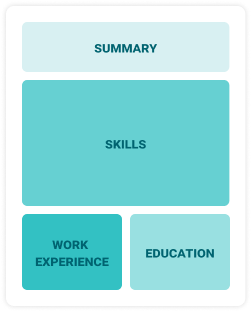
Best for:
Recent graduates and career changers with up to two years of experience
Combination
Balances skills and work history equally
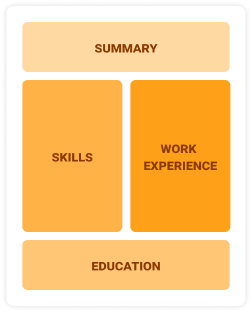
Best for:
Mid-career professionals eager to show their skills and pursue new opportunities
Chronological
Emphasizes work history in reverse order
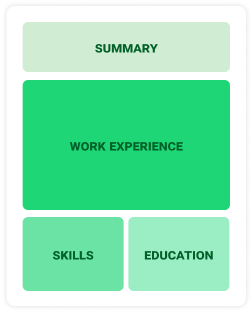
Best for:
Experienced leaders driving innovation in film production and storytelling
Film Salaries in the Highest-Paid States
Our film salary data is based on figures from the U.S. Bureau of Labor Statistics (BLS), the authoritative source for employment trends and wage information nationwide.
Whether you're entering the workforce or considering a move to a new city or state, this data can help you gauge what fair compensation looks like for films in your desired area.
Frequently Asked Questions
Should I include a cover letter with my film resume?
Absolutely. Including a cover letter is a fantastic way to showcase your unique qualifications and passion for the role. It allows you to elaborate on your experiences and make a personal connection with potential employers. If you're looking for resources, our guide on how to write a cover letter is an excellent place to start, or you can use our Cover Letter Generator to create one quickly and easily.
Can I use a resume if I’m applying internationally, or do I need a CV?
When applying for jobs abroad, use a CV instead of a resume if the country typically prefers this format. A CV offers a comprehensive overview of your academic background and work experience. Explore our resources for tips on how to write a CV and discover CV examples that align with international standards.
What soft skills are important for films?
Soft skills such as collaboration, creativity, and communication are essential in film. These interpersonal skills foster teamwork among cast and crew, improve storytelling through shared ideas, and help build strong connections that result in a more cohesive production process.
I’m transitioning from another field. How should I highlight my experience?
Highlight your transferable skills such as creativity, teamwork, and communication when applying for film positions. These abilities showcase your potential to excel in storytelling and collaboration, even if you lack direct industry experience. Use specific examples from previous projects to illustrate how your background informs your filmmaking approach and enriches team dynamics.
Should I use a cover letter template?
Using a cover letter template for film professionals can help structure your application by organizing content effectively and highlighting key achievements such as directing awards or innovative cinematography techniques that capture hiring managers' attention.
How do I add my resume to LinkedIn?
To increase your resume's visibility on LinkedIn, add your resume to LinkedIn and highlight key skills in the "About" and "Experience" sections. This approach helps industry professionals and recruiters easily find qualified job seekers, making networking opportunities more accessible.


